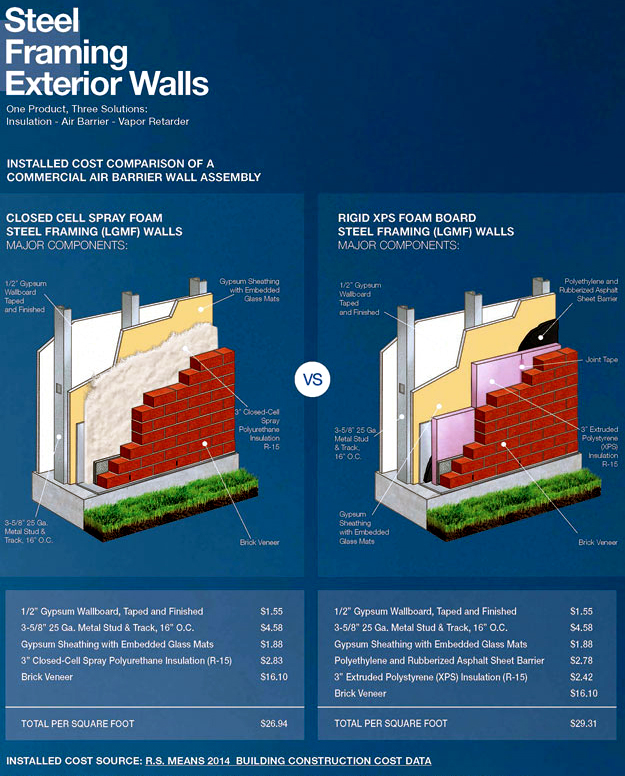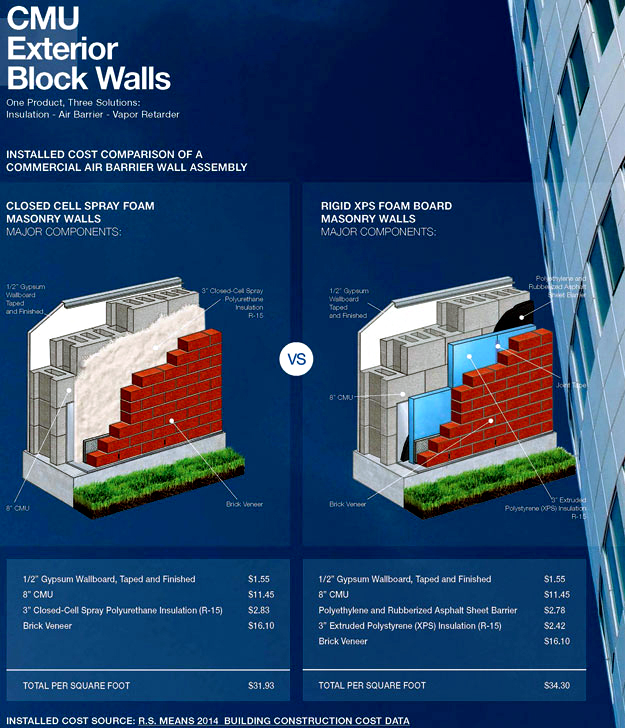Continuous Insulation: Spray Foam Compared to Rigid Boards
In addition to shedding bulk water, the permeance of water vapor through insulation is a justifiable concern. Current thinking on this topic is that it is not only important to prevent the infiltration of gaseous water vapor into a wall, but also to allow for any that does penetrate to leave so the wall can dry. Medium-density spray foam products can help in this regard. Even though they can become a Class II vapor retarder (at designated thicknesses), most would allow an assembly to dry more easily than the equivalent thicknesses of all faced/skinned rigid foam insulation boards and most un-faced foam boards. Therefore, spray foam provides a wall with greater drying potential (to the outdoors) which should result in enhanced durability and longevity. If having a low water vapor permeance material on the exterior side of a wall assembly is a concern, note that the lesser the thickness of medium-density spray foam, the greater the drying potential of the wall. Also consider that membrane materials can be applied in vapor permeable or impermeable versions, so care is needed to ensure that the correct product is chosen for the wall assembly as its drying potential will be affected. For example, a very low water vapor permeance membrane material (class I vapor retarder) used over an entire wall surface, in conjunction with a rigid foam insulation board application, would restrict the drying of the wall much more than a medium-density spray foam application of significantly greater thickness and thermal performance.

Image courtesy of ICYNENE, Inc.
Comparing the cost of rigid XPS foam with spray foam in a stud wall assembly: Spray foam saves money.
Cost Comparisons
There is a common misperception that spray foam costs more to use in an exterior wall assembly than rigid foam boards. By now it should be clear that the only fair and logical way to compare costs is not solely on the basis of product cost (i.e. cost of spray foam installed compared to cost of rigid foam installed) but on the basis of total wall assembly costs using the two different types of insulation. The most notable difference is that medium-density, closed cell, spray foam insulation provides all three functions of thermal resistance, air barrier, and water-resistive barrier in just one product. Rigid foam board insulation provides at best two of the three functions requiring additional products in order to meet code and perform properly. With that in mind, we look at two examples.
Framed Walls
In commercial buildings, it is common to use metal stud framing with interior and exterior gypsum board on the respective sides. Continuous insulation is provided by placing it over the face of the exterior gypsum board and then installing cladding such as brick veneer as the outermost face of the assembly. If the insulation used is rigid board products, then a water-resistant barrier/ air barrier needs to be installed before the insulation is placed. If medium-density, closed cell spray foam insulation is used, then the additional barrier is not needed.
Cost estimates have been performed for this type of wall assembly using 2014 Building Construction Cost Data published by R.S. Means. In this analysis, the installed square foot costs of finished gypsum wall board, metal framing, exterior gypsum sheathing, and brick veneer cladding are the same regardless of the insulation type used. The difference is in the cost of 3 inches (R-15) of spray foam insulation estimated at a cost of $2.83 a square foot compared to the cost of 3 inches (R-15) of XPS insulation at $2.42 plus a sheet barrier estimated at $2.78. When factoring in all costs, the spray foam wall assembly comes out to $26.94 per square foot compared to the rigid board based assembly estimated at $29.31. That is a difference of $2.37 per square foot or over an 8 percent cost savings on the total wall construction when spray foam insulation is used.
Masonry Walls
Another common exterior wall assembly for commercial construction is based on masonry materials. Typically, concrete masonry units (CMU) are the basis of the main wall with face brick installed as the exterior finish surface. The interior surface may be exposed CMU but more often is finished with half inch thick gypsum board. Continuous insulation is often provided in the cavity provided between the CMU and the brick with brick ties passing through it. Note that masonry has been reviewed by a number of authorities for its water resistant properties and has been found to require a water-resistive barrier in order to fully meet the code requirements. Hence, if rigid insulation boards are used, then a water resistant barrier/ air barrier needs to be installed before the insulation is placed. But since medium-density, closed cell spray foam insulation can be readily used in this wall construction type, then the additional barrier is not needed here either.
Once again comparative cost estimates have been prepared based on the R.S. Means 2014 Building Construction Cost Data. For a typical masonry wall, the installed square foot costs of finished interior gypsum, CMU, and face brick remain the same regardless of the insulation type used. As with the framed wall example, the cost difference is found in the wall system that uses 3 inches (R-15) of spray foam insulation estimated at a cost of $2.83 a square foot compared to the cost of 3 inches (R-15) of XPS insulation at $2.42 plus a sheet barrier estimated at $2.78. When factoring in all costs, the spray foam masonry wall assembly totals $31.93 per square foot compared to the rigid board based assembly estimated at $34.30. This is still a difference of $2.37 per square foot or nearly a 7 percent cost savings on the total wall construction when spray foam insulation is used.
Other exterior wall assembly types are certainly designed and constructed beyond these two examples, but the pattern is clear. There is more than enough cost savings in the multiple performance characteristics of spray foam to overcome any small difference in the pure material costs compared to rigid insulation boards plus additional barrier material.

Image courtesy of ICYNENE, Inc.
Using closed cell, medium-density spray foam in a masonry wall is less costly and more time efficient than using rigid board XPS.
Conclusion
Architects and commercial building owners now have the opportunity to maximize their energy savings options with a single product. Medium-density, closed cell spray foam insulation provides a high performance wall assembly solution by combining four functions in one material: truly continuous insulation, a continuous air barrier, a full water-resistive barrier, and a vapor barrier. Further, it has been shown to produce a lower installed cost for a superior thermal, air, and water barrier assembly with less labor and less waste than systems relying on rigid board insulation. From a design standpoint, possibilities are expanded without compromising performance, particularly for curved or irregularly shaped buildings since spray foam can readily adhere to curved, irregular, or unique shapes and conditions. The end result offers greater architectural design flexibility for continuous insulation solutions and better outcomes for building owners and occupants.
 |
The evolution of insulation starts here. ICYNENE's spray foam insulation products are specially formulated to meet the needs of builders, architects, and homeowners. www.icynene.com |








